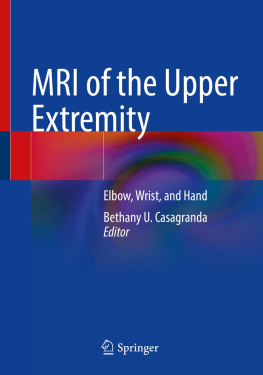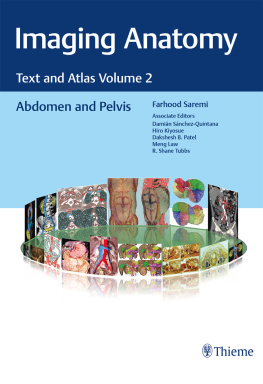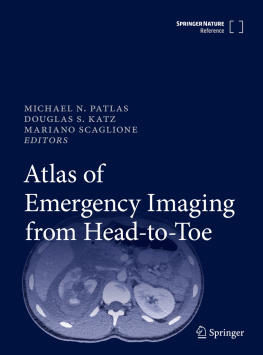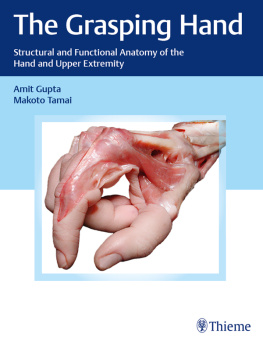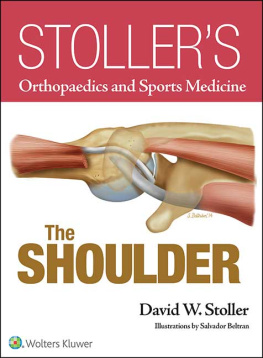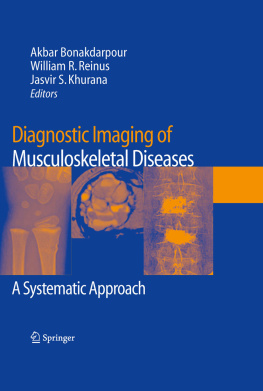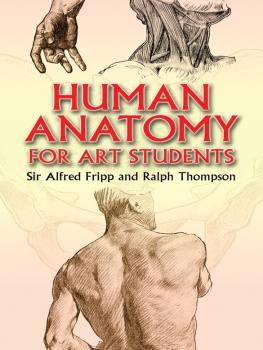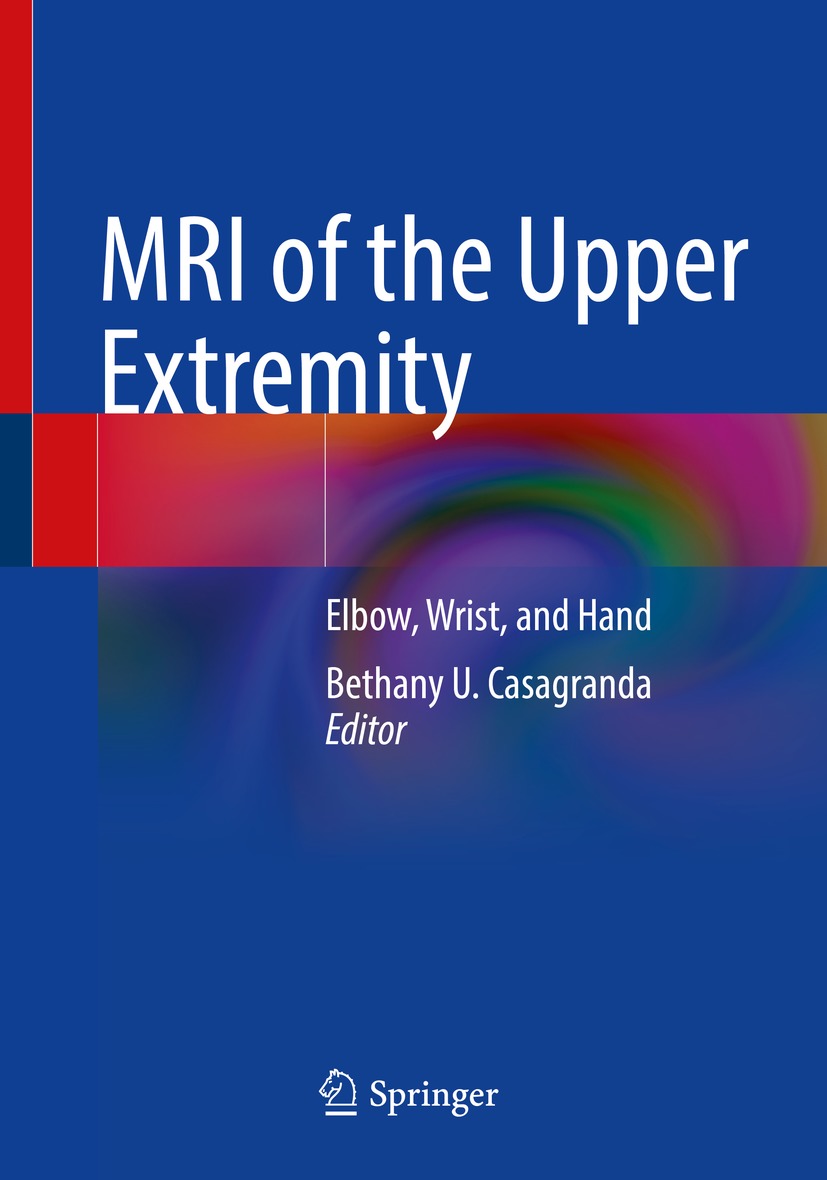Editor
Bethany U. Casagranda
MRI of the Upper Extremity
Elbow, Wrist, and Hand
1st ed. 2022

Logo of the publisher
Editor
Bethany U. Casagranda
Department of Radiology, Imaging Institute, Allegheny Health Network, Pittsburgh, PA, USA
ISBN 978-3-030-81611-7 e-ISBN 978-3-030-81612-4
https://doi.org/10.1007/978-3-030-81612-4
The Editor(s) (if applicable) and The Author(s), under exclusive license to Springer Nature Switzerland AG 2022
This work is subject to copyright. All rights are solely and exclusively licensed by the Publisher, whether the whole or part of the material is concerned, specifically the rights of translation, reprinting, reuse of illustrations, recitation, broadcasting, reproduction on microfilms or in any other physical way, and transmission or information storage and retrieval, electronic adaptation, computer software, or by similar or dissimilar methodology now known or hereafter developed.
The use of general descriptive names, registered names, trademarks, service marks, etc. in this publication does not imply, even in the absence of a specific statement, that such names are exempt from the relevant protective laws and regulations and therefore free for general use.
The publisher, the authors and the editors are safe to assume that the advice and information in this book are believed to be true and accurate at the date of publication. Neither the publisher nor the authors or the editors give a warranty, expressed or implied, with respect to the material contained herein or for any errors or omissions that may have been made. The publisher remains neutral with regard to jurisdictional claims in published maps and institutional affiliations.
This Springer imprint is published by the registered company Springer Nature Switzerland AG
The registered company address is: Gewerbestrasse 11, 6330 Cham, Switzerland
Acknowledgement
To the authors,
I would like to extend my deepest gratitude to every author of this female-dominant project who displayed their talents on the pages of this book. Some of you are my idols, my mentors, my colleagues and my former trainees. All of you are strong, brilliant and remarkable. Continue to contribute to this world as much as you do our beloved field and the world certainly will be a brighter place.
~BUC
To my daughters, Isabella and Eva Helene
I hope my work and service in this life pave a deliberate path in your life. A path where your voice will be easily heard, your place will be visibly present and your talents will be enthusiastically encouraged. The world needs all you have to offer. So when an opportunity arises to better the lives of a few or of many...
Give it all youve got!
~mom
To my husband, Dennis
I am thankful for the encouragement and patience it took to get our household through this project and all the daily endeavours we tackle as a family. Your direct contribution to this book is also appreciated. Any author would be grateful for such an excellent (and affordable) hand model. Much love and gratitude.
~BUC
Introduction
The upper extremity begins proximally at the shoulder and extends distally through the hand. Shoulder is excluded from this text because it is discussed in a dedicated Springer book entitled MRI: Shoulder. This text covers the biomechanical importance, anatomy, traumatic pathology and non-traumatic pathology of the remaining upper extremity joints.
Joint Structure
Joints can be classified by their structure and function. The basis for classifying the joint structure involves defining the material composing the joint and the presence or absence of a cavity. Structural classification of joints includes fibrous, cartilaginous and synovial joints. Fibrous joints, such as the cranial sutures, are bound by connective tissue and have no joint space or cavity. Therefore, fibrous joints are strong but produce very little movement. Cartilaginous joints include the articulations of the spine and pelvis and are either lined or connected to hyaline or fibrocartilage. Cartilaginous joints allow slightly more movement when compared to fibrous joints. Lastly, synovial joints are the only joints to structurally have a cavity or space between bones. This cavity is lined with synovium and occupied by synovial fluid. Synovial joints, supported by several static and dynamic stabilizers, allow for the greatest amount of joint movement allowing one to achieve daily acts of living [1]. All joints of the upper extremity are synovial joints allowing varying degrees of motion. However, the benefit of motion brings an increased vulnerability to injury.
Joint Function
Functional classification of the joint is determined by the motion produced when under force. The six types of synovial joints include pivot or rotary, hinge, saddle, plane, ball-and-socket and condyloid [2]. The upper extremity impressively comprises all of these joint types allowing gross and fine motor movement.
The shoulder joint is a ball-and-socket joint, although it is more correctly described as a ball-and-saucer joint. In contrast to the hip, the other ball-and-socket joint of the body, the socket is much shallower. This allows for less restriction of movement at the joint but compromises stability in the process. The elbow joint commonly referred to as a hinge joint which partially true but does not explain the ability to pronate and supinate the forearm. The articulation of the radial head and the radial notch on the ulna allows for this motion. This creates what is called a pivot joint, allowing the movement of one bone on another. The radiocarpal joint can be classified as an ellipsoidal or condyloid joint. Despite the intercarpal articulations being synovial joints, unlike their counterparts, they do not allow much movement. The interphalangeal joints of the hand are basic hinge joints [3]
Importance of the Upper Extremity
Many of our activities of daily living require proper function of the upper extremity including personal hygiene, dressing and feeding. More complex tasks categorized as instrumental activities of daily living also utilize the function of the upper extremity such as transportation, shopping, and meal preparation and overall household management. All of these tasks can be made incredibly difficult if pain or injury has rendered our upper extremity ineffective or if the patient has difficulty ambulating. Arm swing is an important component of human gait [4]. Despite being bipedal, literature shows how effective arm swing can help create core balance, improve breathing and decrease metabolic energy expenditure necessary to ambulate [5, 6]. Proper use of the upper extremity allows us to interact with the world. Therefore, the recognition of injury to its many parts carries great importance.
References
Classification of Joints | Boundless Anatomy and Physiologycourses.lumenlearning.com boundless-ap chapter.
The six types of synovial joints: examples & definition. Study.com, 20 Dec 2015, https://study.com/academy/lesson/the-six-types-of-synovial-joints-examples-definition.html . Chapter 14 / Lesson 1 Dominic Corsini

